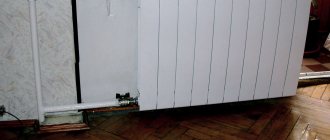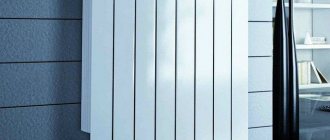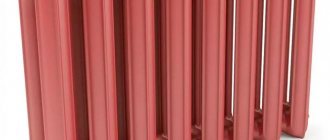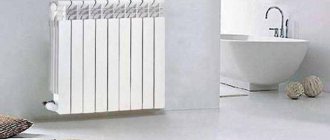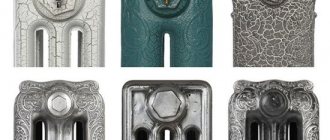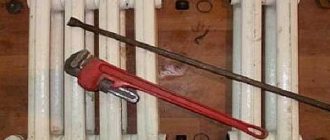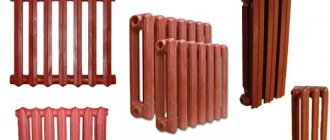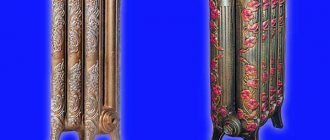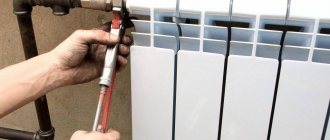Despite the fact that the world has long known aluminum and steel radiators, cast iron radiators are in no hurry to give up their position in heating a private home.
Despite the lack of power and performance, they have a number of undeniable advantages that help them stay afloat and remain competitive. To organize the best heating of your home, it is very important to correctly calculate the power of one section of a cast iron radiator.
Cast iron sectional heating radiators
Cast iron radiators are used not only to meet the needs of private houses, but also apartments. Thanks to the modern approach to the creation of these products, it is possible to purchase not simple standard, but even aesthetic models. Now let's take a closer look at what characteristics any cast iron radiator has.
How to calculate a steel heating radiator for a room?
P = V x 40 + Heat loss through windows + Heat loss through external doors Where: P – radiator
; V – volume of the room (length multiplied by width and multiplied by height);
Interesting materials:
How to find out which applications were opened on Android? How to find out what processor is on an Android smartphone? How to find out what Android you have? How to find out when an application was installed on Android? How to find out who unfollowed on Instagram Android? How to find out the brand of Android? How to find out whether the Android firmware is official or not? How to find out your gmail account password on android? How to find out how much time you spend on each application on your Android? How to find out your Gmail password on Android?
Analysis of the characteristics of a cast iron radiator
There are basic parameters, based on which the owner of a private home chooses a suitable device for himself. Let's look at what these parameters are:
- Power. This is the most basic parameter, based on which calculations are made of how much area one device can heat. Very often, manufacturers indicate the power of only 1 section of a cast iron radiator, which is why the private owner himself will have to calculate how many sections need to be added to the unit for more rational use of the unit.
This is interesting! The power of one section of a cast iron battery is 160 W, and that of an aluminum bimetallic battery is 200.
- Heat dissipation. The heat transfer of a battery depends on the metal from which it is made. As you know, cast iron has lower heat transfer when compared to steel or aluminum. However, there is one interesting pattern that this material has. It consists of the following - cast iron takes a long time to heat up, but it also gives off heat for a long time, so the heat can be retained in the room for quite a long time. Thanks to low inertia, you can maintain the desired temperature level even after turning off the heating.
Connection diagram for cast iron batteries
Tip : cast iron radiators are most effective in open heating systems with natural circulation, because the coolant flows more slowly in them, which helps the radiators warm up quickly.
- Dimensions. Cast iron batteries are quite large and heavy. For owners of two-story private cottages, this is a serious problem, because they will have to independently drag a 60 or 70 kg radiator to the second floor. Yes, and installing such heavy batteries in place is quite problematic alone. The weight of one section is 7 kg, and 10-sections will have a rather impressive mass, which will require 14 liters of water.
Important! If this is not a problem for apartment residents, then private owners will have to rack their brains about how to move such volumes and also heat them.
- Coolant quality. Cast iron does not react with oxygen, in addition, absolutely any liquid can be used as a coolant, even of dubious quality.
Advice: The fact that cast iron batteries can operate on any coolant does not mean that you can pour just anything into the system. Think about the pipeline and the boiler itself - they just need high-quality liquid, because then their service life will be significantly reduced.
Cast iron radiator power
The area of one section of a cast iron radiator is capable of delivering 150 W - this is the minimum value. Depending on the scale of the product, this value can vary - be a little higher or lower, so when choosing a battery in a store, always look at the passport, because it is there that this parameter is indicated.
Moreover, the device will produce 150 W only if the temperature of the coolant differs by 50 degrees from the temperature of the heated room. Thus, to create a microclimate in a room with a temperature of 20 degrees, the liquid must be heated to 70. This is quite possible to do under the conditions of organizing a home heating system. But sometimes it happens that the manufacturer indicates the temperature difference is not 50, but 70 degrees, although this is not entirely correct, because it is not always possible to heat the coolant to such an extent.
Heating 1 square meter requires 1 kW of thermal energy, so for a room of 15 square meters a 10-section cast iron radiator will be sufficient. If the area is, for example, 20 square meters, then it is better to use not one, but two batteries, you just need to calculate their total power.
Remember! It is imperative to take into account the level of your thermal insulation in the room, so as not to make mistakes later in the calculations.
Qualitative characteristics
Before purchasing a heating device, you should study the quality characteristics of various models, showing the design features and manufacturing technology.
Coolants
The technical data sheet for the product must indicate which coolants it can be used with. The permissible range of values of the hydrogen index (pH) of the coolant can also be indicated. If an aluminum radiator is supposed to operate with non-freezing liquids (antifreeze), special intersectional gaskets are used in its design.
Connection diagrams for aluminum radiators.
Connection methods
The standard aluminum radiator section has upper and lower manifolds, allowing for one of the known side connection methods. Some models of heating devices are equipped with a manifold with a lower connecting pipe, allowing for a convenient bottom connection when installing a manifold heating system.
Scheme of coolant flow with bottom connection.
Manufacturing method
Sections can be manufactured by injection molding or extrusion. Extrusion is a forming method that produces a high-density product. Radiators made by this method have higher strength, which allows them to withstand increased pressure.
Aluminum radiators of various sizes.
Aluminum sectional radiators have proven themselves well in individual heating systems, when the homeowner has the opportunity to independently choose the type of coolant and control its quality. Such devices are characterized by high thermal performance, outperforming bimetallic models due to their lower cost. The technical characteristics of aluminum heating radiators give the buyer the opportunity to choose the best model among a number of analogues.
Advantages of using cast iron radiators
Heat transfer calculation
Based on the characteristics, we can highlight the main advantages that cast iron radiators have:
- You can always expand if the power of one section of a cast iron radiator is not enough to meet the needs of the room.
- You can use not the highest quality coolant.
- Affordable price.
- The ability to maintain sufficient temperature even after turning off the boiler equipment.
- A wide selection of different models that can significantly decorate your home.
In addition, resistance to high coolant temperatures should be added to this list. But a significant drawback of such products is their weakness to water hammer, which can damage the battery and reduce its service life. Another disadvantage is the low pressure they can withstand compared to steel and aluminum counterparts.
Calculation example
If you calculate how many sections of an aluminum radiator are needed for a room with an area of 20 m2 at a rate of 100 W/m2, then adjustment coefficients for heat loss should also be made:
- each window adds 0.2 kW to the indicator;
- the door “costs” 0.1 kW.
If it is assumed that the radiator will be placed under the window sill, then the correction factor will be 1.04, and the formula itself will look like this:
Q = (20 x 100 + 0.2 + 0.1) x 1.3 x 1.04 / 72 = 37.56
Where:
- the first indicator is the area of the room;
- the second is the standard number of W per m2;
- the third and fourth indicate that the room has one window and one door;
- the next indicator is the heat transfer level of the aluminum radiator in kW;
- the sixth is a correction factor regarding the location of the battery.
Everything should be divided by the heat output of one heater fin. It can be determined from the table from the manufacturer, which shows the heating coefficients of the carrier in relation to the power of the device. The average for one edge is 180 W, and the adjustment is 0.4. Thus, multiplying these numbers, it turns out that one section produces 72 W when heating water to +60 degrees.
Since rounding is done upward, the maximum number of sections in an aluminum radiator specifically for this room will be 38 fins. To improve the performance of the structure, it should be divided into 2 parts of 19 ribs each.
Calculation by volume
If you make such calculations, you will need to refer to the standards established in SNiP. They take into account not only the performance of the radiator, but also what material the building is built from.
For example, for a brick house the norm for 1 m2 will be 34 W, and for panel buildings - 41 W. To calculate the number of battery sections based on the volume of the room, you should: multiply the volume of the room by the heat consumption standards and divide by the heat output of 1 section.
For example:
- To calculate the volume of a room with an area of 16 m2, you need to multiply this figure by the height of the ceilings, for example, 3 m (16x3 = 43 m3).
- Heat standard for a brick building = 34 W, to find out how much is required for a given room, 48 m3 x 34 W (for a 41 W panel house) = 1632 W.
- We determine how many sections are required with a radiator power, for example, 140 W. For this, 1632 W/ 140 W = 11.66.
Rounding this figure, we get the result that a room with a volume of 48 m3 requires an aluminum radiator of 12 sections.
Additional options for more accurate calculations
Working with a thermal imager
An accurate calculation of the number of heating radiators per area will not be possible without data from technical documents. This is important to more accurately determine the value of heat loss. It is best to determine the level of heat loss using a thermal imager. The device will quickly identify the coldest areas in the room.
Everything would be much easier if each apartment was built according to a standard layout, but this is far from the case. Each house or city apartment has its own characteristics. Taking into account many characteristics (number of window and door openings, wall heights, housing area, etc.), the question reasonably arises: how to calculate the number of heating radiators?
Calculation of heating radiators by area
The peculiarity of the exact method is that more coefficients are needed for calculations. One of the important values that need to be calculated is the amount of heat. The formula is different from the previous ones and looks like this: KT = 100 W/m2*P*K1*K2*K3*K4*K5*K6*K7.
More details about each value:
- KT - the amount of heat needed for heating.
- P - room dimensions m2.
- K1 - the value of this coefficient takes into account the quality of window glazing: double - 1.27; plastic windows with double glazing - 1.0; with triple - 0.85.
- K2 - coefficient taking into account the level of thermal insulation characteristics of the walls: low - 1.27; good (for example, two-layer brickwork) - 1.0; high - 0.85.
- K3 - this value takes into account the ratio of the areas of window openings and floors: 50% - 1.2; 40% - 1.1; 30% - 1.0; 20% - 0.9; 10% - 0.8.
- K4 - coefficient depending on the average statistical air temperature in the winter season: - 35 °C - 1.5; - 25 °C - 1.3; - 20 °C - 1.1; - 15 °C - 0.9; -10 °C - 0.7.
- K5 depends on the number of external walls of the building, the data for this coefficient are as follows: one - 1.1; two - 1.2; three - 1.3; four - 1.4.
- K6 is calculated based on the type of room located on the floor above: attic - 1.0; heated attic space - 0.9; heated apartment - 0.8.
- K7 is the last of the adjustment values and depends on the ceiling height: 2.5 m - 1.0; 3.0 m - 1.05; 3.5 m - 1.1; 4.0 m - 1.15; 4.5 m - 1.2.
The described calculation of heating radiator sections by area is the most accurate, since it takes into account much more nuances. The number obtained during these calculations is divided by the heat transfer value. The final result is rounded to the nearest whole number.
What is an aluminum radiator
Strictly speaking, there are two types of aluminum radiator:
- actually aluminum;
- bimetallic, steel and aluminum.
Structurally, such a radiator is a pipe assembled like an accordion through which hot water flows. Flat elements are connected to the pipe, which are heated by the coolant and heat the air in the room.
A description of the advantages and disadvantages of each type of radiator is beyond the scope of this article, but several important factors can be pointed out. Unlike traditional cast iron ones, aluminum radiators are heated primarily by convection: heated air rushes upward, and a fresh portion of cold air takes its place. Due to this process, it is possible to heat the room much faster.
To this should be added the light weight and ease of installation of aluminum products, as well as their relative cheapness.
